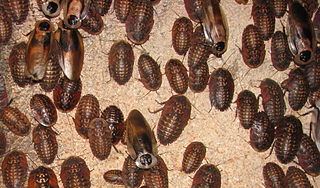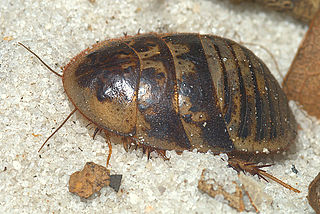
Giant cockroaches, or blaberids, are the second-largest cockroach family by number of species. Mostly distributed in warmer climates worldwide, this family is based on the American genus Blaberus, but much of the diversity is also found in Africa and Asia.

The Florida woods cockroach or palmetto bug is a large cockroach species which typically grows to a length of 30–40 mm (1.2–1.6 in). When alarmed, adults can eject an extremely foul-smelling directional spray up to 1 m, which inspired several of its other common names: Florida skunk roach, Florida stinkroach, skunk cockroach, skunk roach, stinking cockroach, and stinkroach. Two other naming variations include Florida cockroach and Florida woods roach.

Parcoblatta fulvescens, the fulvous wood cockroach, is a species of cockroach endemic to the United States and possibly Canada that measures around 13 mm (0.5 in) long.

Arenivaga is a genus of sand cockroaches, of the subfamily Corydiinae, in the family Corydiidae. These cockroaches live in sandy soils and dunes in the southwestern United States, Florida and Mexico. Arenivaga comes from the Latin arena meaning sand and vagus meaning wandering.

The Transvaal girdled lizard or Reichenow's spiny-tailed lizard is a very flattened girdled lizard from northeastern South Africa, Eswatini, and southeastern Botswana. It prefers rock outcrops in open grassland and feeds on small arthropods, especially beetles.

Tonyosynthemis ofarrelli, more commonly known as the slender tigertail, is a species of Odonata from the family Synthemistidae. It is found in Queensland, Australia, along the eastern coast. They tend to live along or near freshwater streams or rivers, which is also where Odonata tend to lay their eggs.

Phaneroptera nana, common name southern sickle bush-cricket, is a species in the family Tettigoniidae and subfamily Phaneropterinae. It has become an invasive species in California where it may be called the Mediterranean katydid.

Cariblatta lutea is a small species of cockroach native to the United States and other countries, measuring usually around 7 millimeters long as an adult and under 2 millimeters from head tip to abdomen tip at the 1st instar or hatchling. It consists of two subspecies, the small yellow cockroach, and the least yellow cockroach.

Parcoblatta bolliana, Boll's wood cockroach or Boll's wood roach, is a small species of wood cockroach native to the United States, measuring around 11 mm (0.43 in) long.

Parcoblatta lata, the broad wood cockroach, is a species of wood cockroach native to the United States. It is one of the largest species of wood cockroaches.
Griffiniella is one of several cockroach genera in the subfamily Oxyhaloinae. The genus was described by Heinrich Hugo Karny in 1908, and named by him in honour of the prolific author Dr. Achille Griffini of the Royal Technical Institute of Genoa.
Parcoblatta zebra, the banded wood cockroach, is a species of Parcoblatta native to the United States. It has dark transverse bands across the back of its abdomen.
Parcoblatta desertae, the desert wood cockroach or desert cockroach, is a species of Parcoblatta endemic to the United States state of Texas.

Parcoblatta americana, the western wood cockroach, is a species of wood cockroach that occurs in Mexico and the western United States.
Parcoblatta notha, the Arizona wood cockroach, is a species of wood cockroach that occurs only in the southwestern US state of Arizona. It is a relatively large, light colored member of the 12-species wood cockroach genus Parcoblatta. The male has fully developed wings and is able to fly, while the female wings are around half as long and does not fly.

Gyaclavator is an extinct genus of lace bug in the family Tingidae known from a fossil found in North America. The genus contains a single species, Gyaclavator kohlsi.

The Heteropterygidae is a family of stick insects belonging to the suborder Euphasmatodea. Species can be found in Australasia, East and Southeast Asia. More than 130 valid species have been described.

The genus Microrestes combines relatively small and squat Phasmatodea species from continental Southeast Asia and South China.

Orestes japonicus, a stick insect, is a representative of the genus Orestes.

Haaniella gintingi is a stick insect species from Sumatra. It is a typical representative of the subfamily Heteropteryginae. The occasionally used common name Ginting’s Haaniella refers to the species name.















